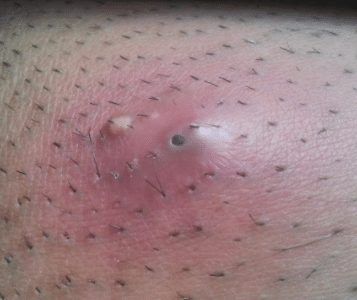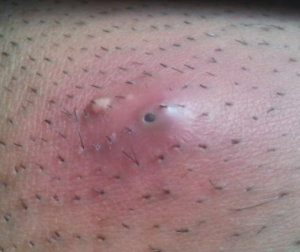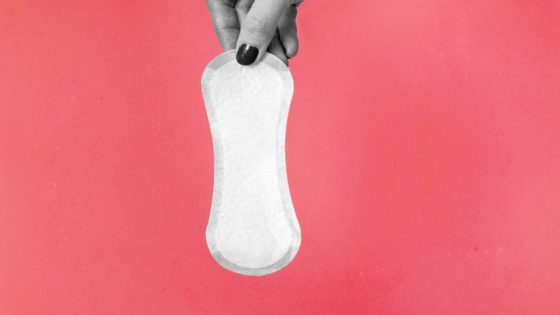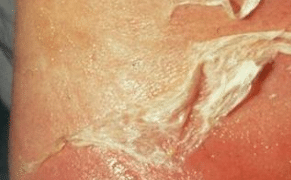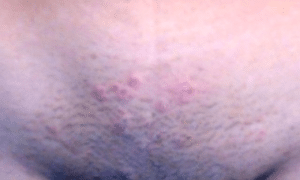What causes an infected ingrown hair? Get more insights on the causes, symptoms and treatment of infected ingrown hair on the legs, face, armpits and head among other parts of the body.
What Is an Ingrown Hair
This is a condition where hair curls back or grows sideways into the skin instead of rising up to the surface of the skin. It occurs mostly among people who have curly or coarse hair. It happens after most ordinary hair removal processes such as shaving, plucking and waxing.
Infected ingrown hair sometimes can result to red spots that are painful due to fungal or bacterial infections. These bumps are mainly characterized by yellowish pus-filled sores and they tend to appear on the face, legs, armpits, neck, inner thigh and groin.
In other cases, an infected hair cyst may form on the mentioned areas. The cyst may resemble sebaceous cyst but it is quite large in appearance. The pus-filled cyst is also painful and may require a serious medical attention.
What Causes Ingrown Hairs – on legs, Armpits, Face, Neck, Head
There are various causes of ingrown hair and among them include the following:
- Having natural coarse and curly hair
Individuals with coarse and curly natural hair are more susceptible to this condition as compared to those with a soft hair type. Curly hair easily grows and coil inside the skin causing the sharp edge to cause pricking of the skin. This leads to itching skin rash that eventually develops into a bump.
The problem can be triggered after shaving, waxing or cutting of hair on the face cause the hard hair to develop bumps. Growing hair will have a chance to curl back to skin since it has sharp pointed tip.
- Clogged hair follicle
Dead skin cell deposit and dirt can clog up a hair follicle and pores especially after shaving and hence causes ingrown hair. The multiplication of hair cell will continue as normal to increase its length but will find no pore to come out of the skin hence will curl backward.
Curling hair inside the skin development will eventually result to painful sores that can easily lead to infected ingrown hair follicles due to contamination that results from the scratching and popping with unsterile objects and dirty hands.
- Poor shaving skill and techniques
Uses of poorly maintained and unhygienic equipment during the hair removal process can result to skin bumps and pores .Use of blunt shaving machine and razor cause injury to hair cell that eventually fail to develop well.
- Hereditary factor of sex hormones
From genetic, some people produces sex hormones responsible for hair growth which may result to having a lot of hair on the body, such people are more likely to have infected ingrown hair.
- Tight clothing
Wearing of tight cloth on your body such as underwear and skinny cloth that do not allow the hair on the skin to grow freely also encourages ingrown hair on the skin. People wearing skinny tight cloth has more susceptible.
Ingrown Hair Symptoms
There are different skin conditions such as scars, red spots, bumps and sores that are caused by ingrown hairs. Here are some of the main signs and symptoms of this condition.
- Inflammation, redness and tender
Inflammation of the hair follicle is known as folliculitis. This is a painful condition that happens when the shaving is poorly done. The skin becomes red and tender implying an infected ingrown hair.
- Development of small, solid hard and rounded bumps.
You will feel some development of small and rounded bumps that is hard. The symptom is often in male after they shave. It may appear on the neck, under the chin and on the cheeks. In women the case is deferent as it may develop on the pubic parts, legs or any other parts of the body.
- Itchy and painful skin.
Itchy skin few days after shaving is a symptom and quick measures on how to get rid of ingrown hairs must be taken into consideration.
- Change of skin color
Skin darkening, the condition known as hyperpigmentation is also a sign. For light skin people these symptoms can be observed fast on the neck, chin, cheeks and other part of the body. The bumps are always dark and can be identified by observation.
- Development of small, pus filed blister
The inflammation of the skin makes it tender and the bumps are filed with pus as a result of bacterial attack of the ingrown hair. The bump eventually swells and burst to release the pus.
Infected Ingrown Hair Causes
Ingrown hair is a problem that affect many people. It is clear that ingrown hair can result from curly hair that is coarse. The curly hair develops under the skin resulting to inflammation and bumps on the skin.
Bumps develop into tender swelling that is filled with pus as a result of bacterial infection of the inflamed part of the skin. From the study, anyone can be affected by these conditions after shaving the hair.
When you shave your hair using poor techniques may result to these conditions. Use of unsterilized razor and shaving machine can infect the root hair with bacteria that attack the bumps.
The affected part of the skin due to bumps is very irritating and these causes the scratching. This easily transmits infection especially when the finger nails are not clean. Scratching also makes the skin to get injuries which creates a chance for secondary infections.
Infected Ingrown Hair Symptoms
Various signs and symptoms characterizes infected ingrown hair. Among the initial ones include the development of painful bumps on the affected area of the skin. The swelling are usually filed with pus as indication of bacteria attack. The painful bumps may be hard or tender.
The condition is usually characterized by irritation of the skin on the affected area. When your skin is infected by bacteria at root of hair, the immediate outcome is the irritation on the skin. This can lead to the formation of a skin rash.
Development of a cyst is also a sign of infection especially when it produces a yellowish discharge. Scars can also form especially when the bumps tend to heal. Bumps are also a main cause of black marks on the skin that can be removed using skin whitening creams.
Infected Ingrown Hair Cyst
An infected ingrown hair cyst come as result of having ingrown hair that fail to come out of the skin due to skin infection. The hair remains under the skin for long time hence develop hard swellings on the skin. The swellings may appear as pimples yet painful due to infection.
Infected Ingrown Hair Follicle
Hair follicle is a mammalian skin organ that produces hair. These parts of the skin can be infected by bacterial due to ingrown hair that causes bump that act as a secondary infection of the follicle. The infected follicle develops a swellings which bear pain.
Infected Ingrown Hair Treatment
Ingrown hair does not often go away on itself and for that reason it needs treatment by the doctor or by using over the counter prescriptions. The doctor may use sterile scalpel or needle to release the bump.
Alternatively the doctor may advocate for steroids medicine that you rub on your skin to ease swelling and irritation. Steroids medicine also makes the affected part of the skin to get healed faster. Antibiotics can be taken orally or directly be applied on skin to treat ingrown hair infection
How to prevent infected ingrown hair
Here are tips on how to prevent further occurrences of this hair and skin condition.
- Use glycolic acid after shaving your hair that helps to exfoliate the skin and prevent ingrown hairs by making the pores open. Shaving cream has glycolic acid that moisturizes the skin and remove dead cell that may cause hair clogging.
- Clean your skin with warm water to exfoliate the skin to remove dead cell that may lead to clogging of the hair.
- When shaving your hair use sterile razor and shaving equipment to prevent bacterial attack that may lead to infections.
Therefore, be mindful when shaving, waxing or removing hair by any other technique to avoid the problem of infected ingrown hair.


